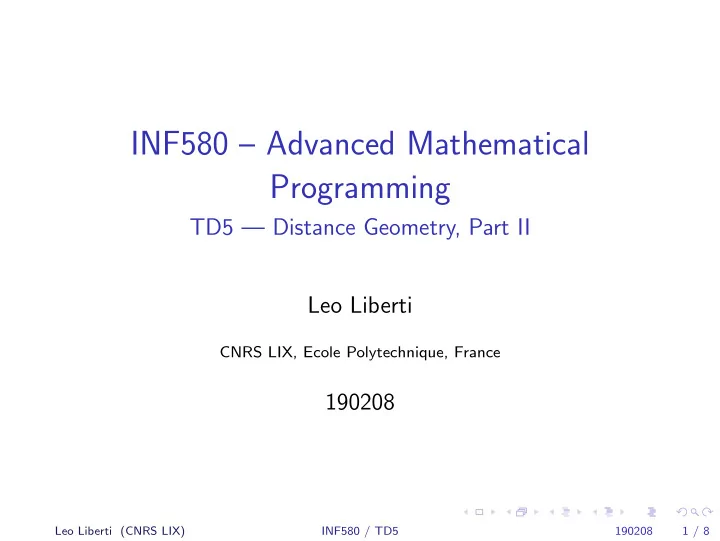

INF580 – Advanced Mathematical Programming TD5 — Distance Geometry, Part II Leo Liberti CNRS LIX, Ecole Polytechnique, France 190208 Leo Liberti (CNRS LIX) INF580 / TD5 190208 1 / 8
Summary ◮ Solving an AMPL formulation in python ( amplpy ) ◮ Solving an SDP formulation in python ( cvxpy ) ◮ Functions readDat , writeRlz , factor , MDS , PCA , mde , lde given as part of the code for this TD ◮ Task 1 : test following algs with 2 given DGP instances ◮ SDP+PCA+NLP ◮ DDP+PCA+NLP ◮ DualDDP+PCA+NLP ◮ Task 2 : replace PCA with Barvinok’s naive algorithm ◮ Task 3 : implement and test the Isomap algorithm for DG Leo Liberti (CNRS LIX) INF580 / TD5 190208 2 / 8
Preparing the environment ◮ Download IPOPT, BonMin, Couenne (and more open-source solvers if you want) by following links in https://ampl.com/products/solvers/open-source/ choose the appropriate architecture (Mac/Lin/Win, choose 64bit unless you have a really old machine) ◮ Once downloaded, the ipopt, bonmin, couenne executables must be moved to your AMPL directory ◮ Install Python packages cvxpy, scs, cvxopt, amplpy using pip install or conda if you use the Anaconda python distribution Leo Liberti (CNRS LIX) INF580 / TD5 190208 3 / 8
amplpy : Running AMPL from Python ◮ Consider the following test.mod # test.mod param n integer, > 1; param m integer, > 1; set N := 1..n; set M := 1..m; param c{N}; param A{M,N}; param b{M}; var x{N} >= 0; minimize objfun: sum{j in N} c[j]*x[j]; subject to lincon{i in M}: sum{j in N} A[i,j]*x[j] = b[i]; ◮ You’ll find a corresponding .dat on the course website ◮ Read model, data, solver, run AMPL, retrieve solution in python Leo Liberti (CNRS LIX) INF580 / TD5 190208 4 / 8
amplpy : Running AMPL from Python from amplpy import AMPL import numpy as np lp = AMPL() lp.read("test.mod") lp.readData("test.dat") lp.setOption("solver", "cplex") lp.solve() ndata = lp.getData("n") n = int(ndata.getRowByIndex(0)[0]) solveres = lp.getData("solve_result") solve_result = solveres.getRowByIndex(0)[0] objfun = lp.getObjective("objfun") objfunval = objfun.value() xvar = lp.getVariable("x") x = np.zeros(n) for j in range(n): x[j] = xvar[j+1].value() Leo Liberti (CNRS LIX) INF580 / TD5 190208 5 / 8
cvxpy: Solving SDPs in Python import sys import cvxpy as cp import math import time import numpy as np n = 5 X = cp.Variable((n,n), PSD=True) A = np.random.rand(n,n) objfun = cp.trace(A.T*X) constr1 = [X[i,i+1] + X[i,i+2] <= -1 for i in range(n-2)] constr2 = [cp.diag(X) == 1] objective = cp.Minimize(objfun) constraints = constr1 + constr2 prob = cp.Problem(objective, constraints) prob.solve(cp.SCS, verbose=True) Xv = X.value print Xv Leo Liberti (CNRS LIX) INF580 / TD5 190208 6 / 8
SDP/DDP/DualDDP + PCA + NLP ◮ Task 1 : test following algs with 2 given DGP instances ◮ SDP+PCA+NLP ◮ DDP+PCA+NLP ◮ DualDDP+PCA+NLP ◮ Task 2 : replace PCA with Barvinok’s naive algorithm ◮ Which is best on quality and efficiency: PCA or Barvinok? Leo Liberti (CNRS LIX) INF580 / TD5 190208 7 / 8
Isomap for DG ◮ Implement all the presented variants ◮ Test them on the two given protein instances ◮ Which variant is best on quality and efficiency? Leo Liberti (CNRS LIX) INF580 / TD5 190208 8 / 8
Recommend
More recommend